In England the term "Backyard" is translated as "backgarden" and Colin is doing some serious Backgarden Metalcasting! He has designed and built some very effective miniature cupola furnaces and they're just dripping (literally!) with molten iron. He even melts iron in a crucible using coal for fuel! Enough said, onto the photos!
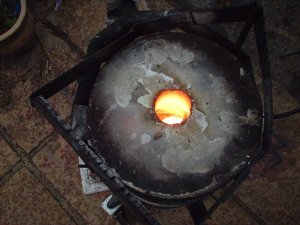 |
I am a "back garden"/ garage workshop player in sunny England (typical August day over here, its pouring down!). I found your site several years ago. Soon after I made my first furnace based on the charcoal foundry by Dave Gingery. Having made a number of experimental furnaces, I have settled on a simple design that burns wood, charcoal, coal, propane and natural gas (too bloody expensive!!), waste veg. oil, used engine oil, parafin and diesel fuel, although I will build a new one soon with insulation. You can just see the crucible which is white hot but the furnace lining doesn't get beyond red (this was melting iron). |
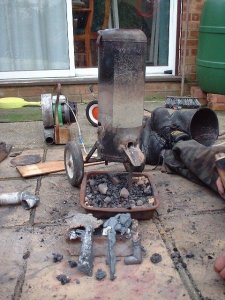 |
The cupola is a 4" bore made from an old fire extinguisher. It melted cast iron from the start but had a tendency for it to solidify in the bottom rather than come out the tap hole, a bit of persuasion with a club hammer and a steel bar cleared it out. It looks like the coal you used is anthacite [A reference to my failed cupola], which used to be used for cupola's in some areas, however I found it took a long time to get it going during warm up and needed more air than coke. Click photo for large view |
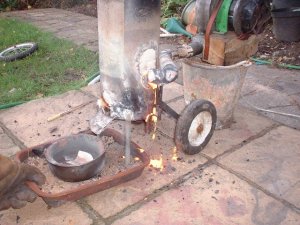 |
I also tried anthracite chippings but these were too small and the iron found it as easy to run out the tuyres as out of the bottom (see pic.). Remember the iron must super heat by coming into as much contact with the fuel as possible on its drop to the bottom. Otherwise it will freeze once it gets there as the well is not anywhere near hot enough to keep the iron molten at a just melted temp. Also keep the tap hole open until a good stream of iron runs out, this will help the bottom get hotter. Click photo for large view |
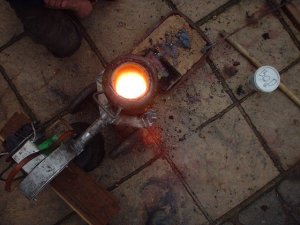 |
Smaller pieces of coke (1/2"-3/4") and around 1-1/2 hours warm up time to get ALL of the bed glowing red before adding any iron then a further 15 mins. to pre-heat the iron and next layer of fuel before turning the blast up for the melt. The warm up was using the blower gently to get the fuel burning without burning away any more fuel than was required to get the bed red from top to bottom. |
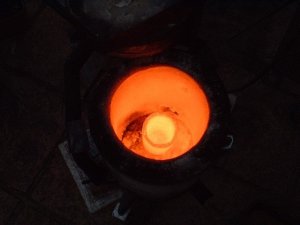 |
I find I can get the iron in a crucible to a "spongey" state where it settles to the bottom of the crucible and can be topped up, on waste oil. I then use diesel to bring it up to pouring temp. Here is a picture showing the white crucible/red furnace lining to demonstrate my need for insulation. |
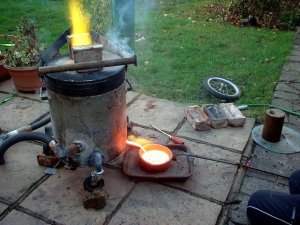 |
I hope with an insulated furnace all can be achieved with waste oil, if not, well I can afford to use a little diesel to top up the heat. Please remember I am not an expert, this is just a bit of the playing around I have been doing, I have yet to cast any iron that didn't "kill" the tool bit as soon as I showed it to my castings!! However I am soon going to try a new iron supply I have discovered at work (plenty of it and FREE!!) Click photo for large view |
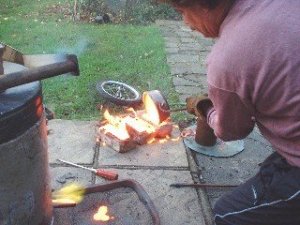 |
The other pics show my present furnace (although it has been modified a lot since) "batch melting" iron using coke. This was the first attempt which was a complete success (that surprised the hell out of me!!). I decided the cupola was too small and fiddley and gave it away (it melted around 6-7 lbs per charge) but it was fun. Batch melting in the other one although working well is very hard on the lining (it has cracked in a few places, probably due to the thermal shock caused by knocking the bottom out when very hot and the cold air rushing in the bottom as the hot air shoots out the top). Around 20lbs. of iron seems about max. with the bed height. |
 |
The black surround is bright afternoon sunshine, the coals hurt your eyes to look at them but in the picture it looks like nothing. I don't know if you have tried melting iron using coal/coke in a crucible furnace, your anthracite should work fine. Something along the lines of a Gingery style charcoal furnace but large enough to have the crucible surrounded with fuel. With either twin tuyeres or a solidly made grate in the bottom (to allow air to evenly reach all the fuel) will do the job. The pic I sent of the furnace tapping iron worked fine with crucible iron and coke, I had to lift the pot a couple of times to add more fuel. As with cupola melting, the fuel must all be burning red before the full blast is put on. The coals and the pot should be white hot "in blast." |
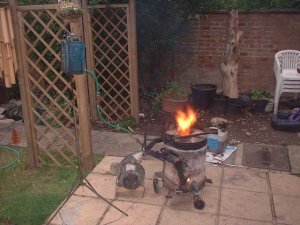 |
Here is one of burning cooking oil melting alli. The interest in furnaces came about to improve the range of engines I could make with my hobby of model engineering, however I now realize that the possibilities are almost endless. I have cast a few parts for my boat with plans to make many more as I "fix her up." A Gingery shaper is on the cards as well. I don't at this stage think I will need to melt more than 20-25lbs. of iron so my present set up is fine. I can melt a gallon container of alli, brass or bronze with oil. |
Colin's newest furnace!It easily melts iron with used motor oil! Either with a crucible or without one (cupollette or reverbatory furnace) style! |
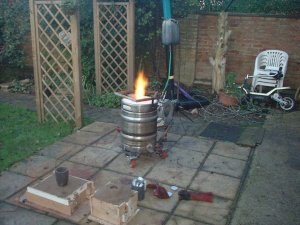 |
I finally have almost finished my new insulated furnace, it is now in a usable condition, although I have still to make a new fuel regulator and the fan guard (I have made and fitted the belt guard, not shown in the pics). The skin is a stainless steel beer barrel which has been kicking around in my garden for a year or so, which determined the overall size of the furnace. And as I wanted to keep the 10" bore I have on my old one, I was limited to how much insulation I could use. It is enough to do the job but the skin gets very hot. Another couple of inches would make a lot of difference. A new fan/fuel set up completes the job. Click photo for larger view |
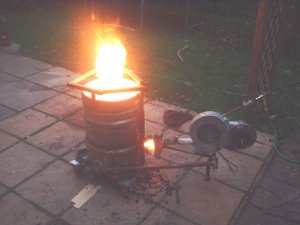 |
It has no problem melting cast iron on engine oil, either in a crucible or directly in the furnace taped at the spout (I haven't tried cooking oil yet as I've run out, and as I have plenty of engine oil I haven't bothered to re-supply. I will get some next week). I have also tried 50/50 engine oil and diesel and the results were incredible (see pic). I don't think melting steel is going to be a problem. I have "upped" the lining to 1700° C. (3092° F.) from the 1600° C. (2912° F.) I used on the last one which was a good move. I was melting the surface of the 1600 and the new furnace runs a lot hotter. Click here to see more of this improved furnace! |










